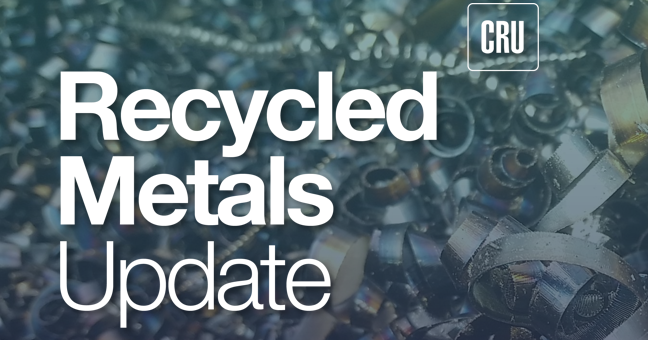Scrap Prices North America

The most underappreciated scrap grade
Written by Stephen Miller
April 10, 2024
Over the last several years, I have noticed widening spreads between #1 Heavy Melting Steel (ISRI 201) and Shredded (ISRI 210,211), as well as Plate & Structural (ISRI 232).
Shredded has grown in popularity among EAF producers. It has its advantages. But does it warrant the kind of spreads we are experiencing in today’s scrap market?
These grades have about the same Fe content, and they all contain high alloy residual levels as compared to #1 Busheling (ISRI 207). Despite the chemical similarities of HMS, P&S, and shredded scrap, there seems to be a reluctance on the part of the EAF sector to use HMS – except at a much cheaper price.
Why is HMS so cheap in the US?
These grades are not similar in physical characteristics. HMS and P&S are generally cut 5’ X 2’, thereby having less density than shredded scrap. Shredded scrap is much smaller and melts more uniformly than HMS. But does this fact make HMS worth that much less than shredded considering the Fe content?
| Grade | Fe Content (est) | Residuals | Density | Price April |
| Shredded | 94% | Cu, Cr | 50-70 lbs/cu ft | $415 gt Chicago |
| #1 HMS | 93% | Cu, Ni, Cr | 55 lbs/cu ft | $325 gt Chicago |
| 5′ P&S | 95% | Cu | 55 lbs/cu ft | $400 gt Chicago |
The spread between shredded and HMS in Chicago this month is at $90 per gross ton (gt)! Really? The spread between HMS and P&S is $75/GT. This is according to several scrap publications that follow local pricing. Basically, HMS has a similar specification to P&S, except it’s not true plate and structural steel. Both roughly have the same basic density. There may be a bit more residual alloys in HMS. But certainly not enough to justify this type of discount.
At this type of discounted price for #1 HMS in the Chicago/Detroit districts, integrated mills there must be enjoying using this grade as coolant in their basic-oxygen (BOF) furnaces as opposed to other much more expensive grades. The EAFs making the flat-roll could be losing some of their price advantage by not figuring out a way to incorporate HMS into their melts.
These wild price differences are less pronounced in the districts in the Southeast, where the price of #1 HMS is reported at $350/gt-$360/gt. This is more reasonable considering P&S and Busheling are at $375/gt and $400/gt, respectively. Still, it seems like too much of a spread if you review the specifications and consider the Fe yields.
Its value is recognized abroad
The grade of #1 HMS was the bellwether scrap grade in the US for decades, until shredded scrap took over with the proliferation of the shredder over the last 20 years. However, it is still generated in vast quantities in the US.
The main export grade in the US and across the globe is a hybrid grade of 80% #1 HMS and 20% #2 HMS. In April, this grade is worth about $350/gt FOB USEC/USGC to deliver to Turkey in the low $390s. So, in Turkey, it’s worth $390/gt. But in Chicago it’s only worth $325/gt. And that’s with a 20% inferior blend bringing the Fe yield to a significantly lower level.
The spreads between shredded and HMS 80/20 in Turkey and Mediterranean Basin are not like those in US. Until two years ago, shredded carried only a $5-per-metric-ton (mt) premium over 80/20. Today, it’s risen to $20/mt. On the West Coast, it’s $5/mt-$10/mt.
So how come it’s so different here?
The takeaway
Given predictions of future increases in scrap demand and with new capacity being installed over the next several years, there should be a window to use #1 HMS to blunt runaway price increases. It would recapture its rightful status among the #1 grades of scrap in North America.

Stephen Miller
Read more from Stephen MillerLatest in Scrap Prices North America

HRC vs. scrap spread widens over $150/ton in March
The HRC vs. prime scrap spread increased again in March.

HRC vs. prime scrap spread increases in February
The price spread between hot-rolled coil (HRC) and prime scrap widened in February ahead of the implementation of President Trump’s tariffs on steel.
HRC vs. prime scrap spread narrows again in January
The price spread between hot-rolled coil (HRC) and prime scrap continued to narrow in January, according to SMU’s most recent pricing data. While SMU’s average HRC price edged down week over week (w/w), it rose compared to a month ago. The January price for busheling also increased from December. Our average HRC price as of […]

HRC vs. prime scrap spread flat in November
The price spread between hot-rolled coil (HRC) and prime scrap remained the same in November as both tags were at the levels seen a month earlier, according to SMU’s most recent pricing data.

HRC vs. busheling spread narrows slightly in October
The price spread between hot-rolled coil (HRC) and prime scrap narrowed marginally in October, according to SMU’s most recent pricing data.
